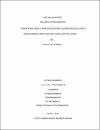OPERATIONAL MODEL ANALYSIS AND FINITE ELEMENT MODEL UPDATE USING AMBIENT VIBRATION DATA FOR AL-SINYAR TOWER
| Advisor | Hussein, Mohammed Farouk Mohammed |
| Author | AL-KHAMIS, KHALID |
| Available date | 2019-05-26T06:43:27Z |
| Publication Date | 2018-01 |
| Abstract | Buildings in Qatar rely on minimum structural code requirements implemented by design consultants’ offices. Qatar 2030 vision considers increasing of structures’ sustainability and serviceability as a high priority, which require testing structures under real full scale modeling. The process of monitoring structures’ behavior over time for aerospace, civil and mechanical engineering infrastructure is referred to as structural health monitoring (SHM). In Qatar, most high-rise building stability design is based on wind loading. According to Uniform Building Code3 1997 (UBC1997) which classifies seismic zones on a scale of zero to four, Qatar’s seismic classification on the scale is zero which is the minimum seismic risk value. Qatar Meteorological data on wind speeds enabled analysis of extreme winds to be undertaken in structural designs. This study aims to identify dynamic properties of the structural by using wired and wireless accelerometers in order to assess structural performance to update Finite Element Model (FEM). By updating FEM, engineers are enabled to support clients to make quick and correct decisions in extreme emergency situations in the case of boundary conditions changes and loads such as seismic vibration and wind pressure changes, during a structure’s life. The objective of this research is to apply and evaluate a single output-only procedure on a reinforced concrete tower building, Al Sinyar Tower, which consists of 2B+G+52 floors in Al Dafna Area in Qatar, with a total built up area of 74,747 sqm and is the tallest residential building in Qatar with a total height of 230 m . A Finite Element model using Sap2000 program was used to model and analyze building values in order to compare results with the real test results. The different forms of response data from ambient vibration were scrutinized to evaluate structure performance. Mode shapes, natural frequencies, modal damping ratios were studied, while the results of tests carried under ambient conditions were used to update the Finite Element model based on modules of elasticity, density and also connections fixity. The thesis concluded that wired sensors are not practical to use for low frequencies measurements in high rise buildings and that it is tremendously challenging and difficult to deal with more than 1000 meter long cables, especially with a very sensitive devices. Frequencies values from wired sensors could not been captured, whereas wireless connection provided more reasonable values. Ambient vibration results based on as-built environment provided higher frequency values in comparison to FEM because the stiffness provided by cladding, façade and walls eventually increased the system’s stiffness, which cannot be revealed in FEM based on structural drawings only. The foremost concept of Model Updating is to have an ideal simulation of structure that can represent real structure behavior. The Final Updated model results founded satisfactory according to modal assurance criterion (MAC) value with 98.9% and frequency deference errors average of 7.6%. |
| Language | en |
| Subject | AL-SINYAR TOWER wired sensors wireless connection ideal simulation |
| Type | Master Thesis |
| Department | Civil Engineering |
Files in this item
This item appears in the following Collection(s)
-
Civil Engineering [48 items ]


